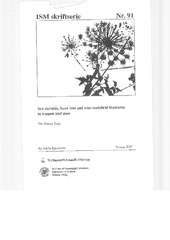Sex steroids, bone loss and non-vertebral fractures in women and men : the Tromsø study
Permanent lenke
https://hdl.handle.net/10037/26308Dato
2007Type
Doctoral thesisDoktorgradsavhandling
Forfatter
Bjørnerem, ÅshildSammendrag
When this thesis was planned in 2000-2001 it was well known that bone loss accelerates after
menopause, and is prevented by using hormone replacement therapy (HRT). Case
reports of young men with estrogen receptor dysfunction or aromatase deficiency showed that
estrogen was important for normal growth and maturation of the male skeleton.
However, there were few prospective studies examining the contribution of endogenous sex
steroids on bone loss and fracture risk in women, and no prospective study in men.
We wanted to know if levels of sex steroids were relevant as predictors of bone loss and
fractures and whether this knowledge could be useful for developing future treatment by low
dose of HRT. During the work on this thesis results from a large randomized controlled trial
assessed the risks and benefits of estrogen plus progestin treatment in 16,608 healthy
postmenopausal women. The investigators concluded that the overall health risks
exceeded benefits from the use of estrogen plus progestin in this group. They estimated
hazard ratios with 95% confidence interval as follows: coronary heart disease 1.29 (1.02-
1.63); breast cancer 1.26 (1.00-1.59); stroke 1.41 (1.07-1.85); pulmonary embolism 2.13
(1.39-3.25); colorectal cancer 0.63 (0.43-0.92); endometrial cancer 0.83 (0.47-1.47) and hip
fracture 0.66 (0.45-0.98). This publication led to a reassessment of the role of HRT, which
was no longer recommended in women for fracture risk reduction alone.
Left unresolved was the question whether women and men with low levels of circulating
sex steroids have higher risk of bone loss or fractures. This was still relevant for our
understanding of the contribution of sex steroids on bone fragility. From a clinical point of
view it was interesting to know, if sex steroids are relevant predictors of bone loss or
fractures, if these measurements could be useful in signalling the need for further
investigation or treatment.
Forlag
Universitetet i TromsøUniversity of Tromsø
Serie
ISM skriftserie Nr. 91, 2007Metadata
Vis full innførselSamlinger
- ISM skriftserie [161]
Copyright 2007 The Author(s)


 English
English norsk
norsk